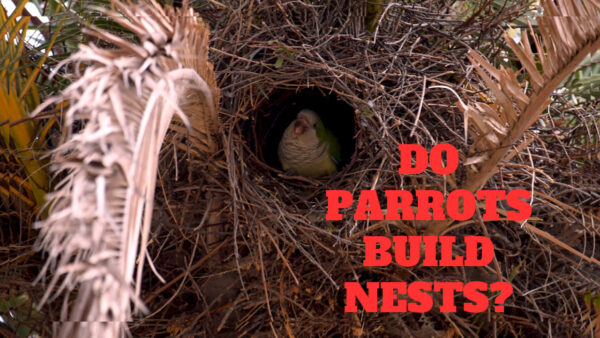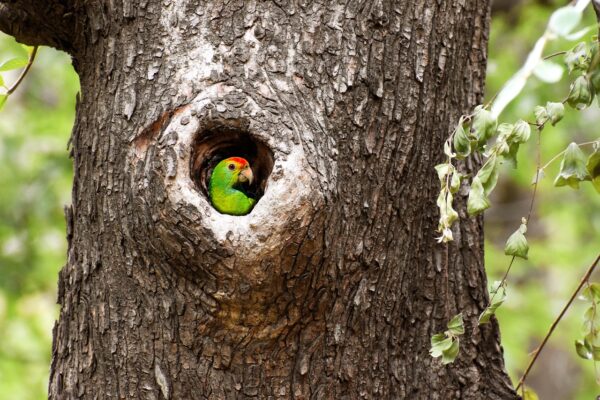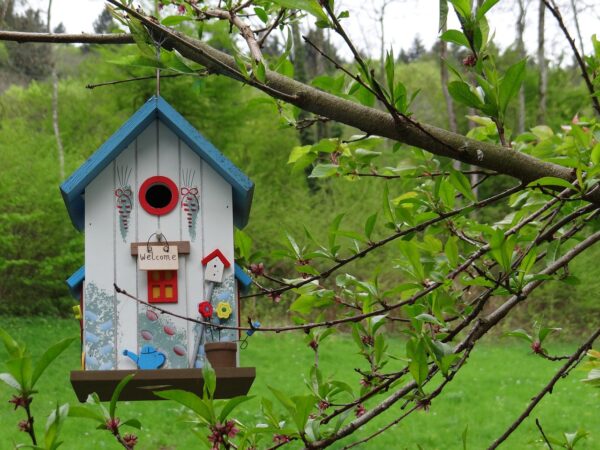Do Parrots Build Nests?
“Do Parrots Build Nests?” The answer to this question is both yes and no. It depends on the parrot species.
Some parrots make their nests, while others do not. According to official research, there are only 9 species of parrots that nest including the monk parakeet, 5 species of lovebirds and three species of ground parrots. Many species of parrots, especially cockatoos, build their nests in tree hollows, rocks, and holes in the ground.

Contents
- 1 Do Parrots Build Nests?
- 2 Why do parrots build nests?
- 3 Where do parrots build their nests?
- 4 What about parrots that don’t nes
- 5 What is a Nesting Box?
- 6 Why shouldn’t you make your parrot a nest at home?
- 7 What should I do if I see a parrot that has fallen from the nest?
- 8 Where is the strangest place a parrot’s nest?
- 9 FAQ
- 10 Conclusion
But, we still have some questions in our mind regarding this…
- Why do some parrots make nests?
- Where do parrots make nests?
- What are nests made of?
- How do they even know how to make a nest?
- And what are nesting boxes?
We will find all the answers to all questions and learn more about parrot nesting behaviour, let’s start.
Why do parrots build nests?
The main reason birds build nests is to raise their chicks. Nests are like a home for them where they raise their chicks and feel safe. The nest is like a home for them where they can lay their eggs and incubate them. The nest may help them escape and hide from predators and other enemy birds. For the first 2–3 weeks after birth, the nest also serves as a home for the baby birds or a place where they can stay while their mother and/or father are forging for food for them.
Where do parrots build their nests?
Parrots and other birds may nest in different places. The most common place where we will find birds’ nests is on trees. We have probably seen birds making nests around our house too. Other places where we can see birds nesting include on the ground, in burrows or on rocks. But how does one determine where a bird wants to build its nest?

Be it parrots or any other bird, they would like to build their nest only where they and their children can live or feel safe. Why they can do it? Because they want their chicks to be safe from predators and enemies. This is why most birds will build their nests high in trees, where most predators cannot reach the chicks from there.
Most birds will build their nests in any corner or groove where they feel they will be safe. Unfortunately, not all predators live on land. Birds of prey that hunt eggs and young, such as hawks, eagles and owls, can all fly. For this reason, nesting at height is not always a safe option, which is why birds are always looking for places where they can hide their nests.
What about parrots that don’t nes
As we discussed above, not all parrots build nests. There are over 300 different species of parrots found in the world, but only a few species are known to build their own nests. So what do other parrots do? They often look for holes or pits in trees to make nests where they can lay their eggs. Some parrots find burrows in trees, while others burrow in the ground, on cliffsides or even under rocks. There are some species of parrots, like billowing parrots, they make holes in trees for themselves and make nests in them. Although some parrots do not build their own nests, they still choose a place where they can lay their eggs. Parrots are always looking for a nesting area where they can feel safe and away from humans and predators and which is also close to a food supply.
What is a Nesting Box?
Nesting boxes are something that parrot owners can purchase if they want to breed their parrots. It is a dark box where your parrot can feel safe and secure while laying its eggs. Most nest boxes are made deep, and even those made in L shape are more popular. This type of shape allows your parrot to go to a place where they cannot be seen from the entrance. Other features of the nesting box include inspection doors and a peephole. The entrances should be narrow so that your parrot can enter. Nesting box requirements vary from species to species. If you plan on breeding your parrots, check the appropriate species requirements or ask an expert.

Why shouldn’t you make your parrot a nest at home?
Unless you plan on raising your parrot’s babies, it is not a good idea to allow them to build a nest. Why? Because the nesting instinct comes with hormones. Hormonal parrots are like hormonal teenagers. They make the nest as well as a mess, they are also aggressive and noisy, and may even start biting when you wander around their nest, which is not safe for children. In the wild, parrots begin building their nests when conditions are suitable for breeding. For example, most parrots will begin building their nests when the summer season approaches and there is abundant food available. This means that the breeding season and nesting occur over only a few weeks each year. This also means that once those weeks are over, the parrot’s hormones will go away and the parrot’s behaviour will return to normal. In captivity, conditions are always suitable for nesting. You provide them with food and a cage or nest box with a suitable temperature for them to live in year-round. This means that nesting behaviour can happen at any time and it could happen due to hormones. If you want to avoid this type of behaviour of parrots, then you have to stop them from doing this. How can you stop them from making a nest? Don’t let them go to any dark, lonely areas of your home. If your parrot is hiding in your cupboard or closet, they are probably making a nest. If they are hiding behind your curtains, they are looking to build a nest. When they build a nest their behavior changes suddenly. To avoid hormones and behaviour, keep your parrots away from dark areas where they can do this unless you are trying to breed.
What should I do if I see a parrot that has fallen from the nest?
If you find a parrot chick outside of its nest, it is best to leave them alone. It may be good to help parrot chick, but it may cause them more harm than good. In some other cases, it may happen that the chick was trying to fly out of the nest and missed. This is probably the case if the parrot’s wings are open and the body is covered with feathers. If the wings are not developed and the full body is not covered with feathers, the parrot is probably too small. In this issue, you can try to put the chick in its nest (if the nest is within your reach). If the nest is out of your reach, you can make another nest and put the chicks in it. If you find a parrot cheek, never wait to see if its parents return. If you are around the nest, they will not come near their cheeks because they are afraid of you. Second, never give food or water to the bird because baby parrots do not drink water, they get everything they need from food. Their diet is highly adapted to what they are fed by their parents. Any attempt to feed them from outside may ultimately harm them. If you find a baby parrot outside its nest, the best thing to do is to leave it there. The more you intervene, the lesser the chances of survival.
Where is the strangest place a parrot’s nest?
In a termite heap! This may seem strange, but it is actually not as unusual as it seems. The grey-cheeked parrot, orange-fronted conure and green-rumped parrot are all known to build nests in trees and in mounds of grass located on the ground. Termites are present most of the time when parrots are building their nests. Termite mounds are suitable for making nests because they can survive rain, fire and storm.
FAQ
Do parrots build nests in the wild?
Yes, many species of wild parrots build nests. Nesting behaviour may vary depending on the parrot species.
What materials do parrots use to build nests?
Parrots use a variety of materials to build their nests, they use twigs, leaves, and feathers.
How do parrots select a nesting site?
Parrots often search for suitable nesting sites in tree hollows, termite mounds, cracks or cavities in rocks.
Do captive parrots exhibit nesting behavior?
Yes, some species of parrots reuse their nests over several breeding seasons, while others build new nests each time.
How long does it take for parrot eggs to hatch?
Different species of parrots take different amounts of time to hatch, but they hatch within 18 to 30 days.
Can parrots reuse their nests?
Yes, some species of parrots reuse their nests over several breeding seasons, while others build new nests each time.
Conclusion
Parrots often make nests. Some parrots make their own nests, but most parrots nest in tree holes and cavities that have already been made for them. If you are planning on breeding and raising a family of your parrot, purchase a good nesting box where your parrot can live safely. If you are not planning on breeding, do not allow your parrot to build a nest. If you do this, their hormones will go out of control and you’ll have a moody parrot on your hands!
